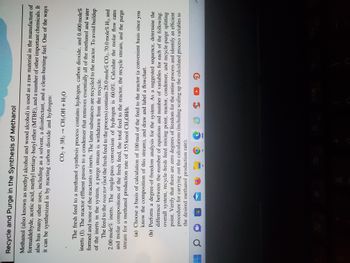
Introduction to Chemical Engineering Thermodynamics
8th Edition
ISBN: 9781259696527
Author: J.M. Smith Termodinamica en ingenieria quimica, Hendrick C Van Ness, Michael Abbott, Mark Swihart
Publisher: McGraw-Hill Education
expand_more
expand_more
format_list_bulleted
Question
thumb_up100%
Use the atomic species balance for this. Chemical Engineering: Material Balance.

Transcribed Image Text:Recycle and Purge in the Synthesis of Methanol
Methanol (also known as methyl alcohol and wood alcohol) is used as a raw material in the manufacture of
formaldehyde, acetic acid, methyl tertiary-butyl ether (MTBE), and a number of other important chemicals. It
also has many other uses, including as a solvent, a disinfectant, and a clean-burning fuel. One of the ways
it can be synthesized is by reacting carbon dioxide and hydrogen:
CO₂ + 3H₂ CH3OH + H₂O
-
The fresh feed to a methanol synthesis process contains hydrogen, carbon dioxide, and 0.400 mole%
inerts (I). The reactor effluent passes to a condenser that removes essentially all of the methanol and water
formed and none of the reactants or inerts. The latter substances are recycled to the reactor. To avoid buildup
of the inerts in the system, a purge stream is withdrawn from the recycle.
The feed to the reactor (not the fresh feed to the process) contains 28.0 mole% CO2, 70.0 mole% H₂, and
2.00 mole% inerts. The single-pass conversion of hydrogen is 60.0%. Calculate the molar flow rates
and molar compositions of the fresh feed, the total feed to the reactor, the recycle stream, and the purge
stream for a methanol production rate of 155 kmol CH3OH/h.
(a) Choose a basis of calculation of 100 mol of the feed to the reactor (a convenient basis since you
know the composition of this stream), and draw and label a flowchart.
(b) Perform a degree-of-freedom analysis for the system. As a suggested sequence, determine the
difference between the number of equations and number of variables for each of the following:
overall system, recycle-fresh feed mixing point, reactor, condenser, and recycle-purge splitting
point. Verify that there are zero degrees of freedom for the entire process and identify an efficient
procedure for carrying out the calculations (including scaling up the calculated process variables to
the desired methanol production rate).
€
3
Expert Solution
This question has been solved!
Explore an expertly crafted, step-by-step solution for a thorough understanding of key concepts.
Step by stepSolved in 3 steps with 3 images

Knowledge Booster
Similar questions
- Explain the differences between crystal structure and crystal system. How are these concepts related, and why is it important to distinguish between them in materials science?arrow_forwardExamine the influence of molecular dipoles on the interaction between polar and nonpolar molecules. How do these interactions affect the mixing and stability of solutions in chemical engineering processes?arrow_forwardExperimental techniques for fast reactions. What is temperature jumped methodarrow_forward
- Write chemical structures names for the repeat polyethylene, poly(propylene), poly(vinyl chloride), polystyrene and polyamide 66.arrow_forwardExplain the chemical processes of esterification, pyrolysis and polymerization.arrow_forward4 Briefly describe the EOR principle of polymer flooding.arrow_forward
arrow_back_ios
arrow_forward_ios
Recommended textbooks for you
 Introduction to Chemical Engineering Thermodynami...Chemical EngineeringISBN:9781259696527Author:J.M. Smith Termodinamica en ingenieria quimica, Hendrick C Van Ness, Michael Abbott, Mark SwihartPublisher:McGraw-Hill Education
Introduction to Chemical Engineering Thermodynami...Chemical EngineeringISBN:9781259696527Author:J.M. Smith Termodinamica en ingenieria quimica, Hendrick C Van Ness, Michael Abbott, Mark SwihartPublisher:McGraw-Hill Education Elementary Principles of Chemical Processes, Bind...Chemical EngineeringISBN:9781118431221Author:Richard M. Felder, Ronald W. Rousseau, Lisa G. BullardPublisher:WILEY
Elementary Principles of Chemical Processes, Bind...Chemical EngineeringISBN:9781118431221Author:Richard M. Felder, Ronald W. Rousseau, Lisa G. BullardPublisher:WILEY Elements of Chemical Reaction Engineering (5th Ed...Chemical EngineeringISBN:9780133887518Author:H. Scott FoglerPublisher:Prentice Hall
Elements of Chemical Reaction Engineering (5th Ed...Chemical EngineeringISBN:9780133887518Author:H. Scott FoglerPublisher:Prentice Hall
 Industrial Plastics: Theory and ApplicationsChemical EngineeringISBN:9781285061238Author:Lokensgard, ErikPublisher:Delmar Cengage Learning
Industrial Plastics: Theory and ApplicationsChemical EngineeringISBN:9781285061238Author:Lokensgard, ErikPublisher:Delmar Cengage Learning Unit Operations of Chemical EngineeringChemical EngineeringISBN:9780072848236Author:Warren McCabe, Julian C. Smith, Peter HarriottPublisher:McGraw-Hill Companies, The
Unit Operations of Chemical EngineeringChemical EngineeringISBN:9780072848236Author:Warren McCabe, Julian C. Smith, Peter HarriottPublisher:McGraw-Hill Companies, The

Introduction to Chemical Engineering Thermodynami...
Chemical Engineering
ISBN:9781259696527
Author:J.M. Smith Termodinamica en ingenieria quimica, Hendrick C Van Ness, Michael Abbott, Mark Swihart
Publisher:McGraw-Hill Education

Elementary Principles of Chemical Processes, Bind...
Chemical Engineering
ISBN:9781118431221
Author:Richard M. Felder, Ronald W. Rousseau, Lisa G. Bullard
Publisher:WILEY

Elements of Chemical Reaction Engineering (5th Ed...
Chemical Engineering
ISBN:9780133887518
Author:H. Scott Fogler
Publisher:Prentice Hall


Industrial Plastics: Theory and Applications
Chemical Engineering
ISBN:9781285061238
Author:Lokensgard, Erik
Publisher:Delmar Cengage Learning

Unit Operations of Chemical Engineering
Chemical Engineering
ISBN:9780072848236
Author:Warren McCabe, Julian C. Smith, Peter Harriott
Publisher:McGraw-Hill Companies, The